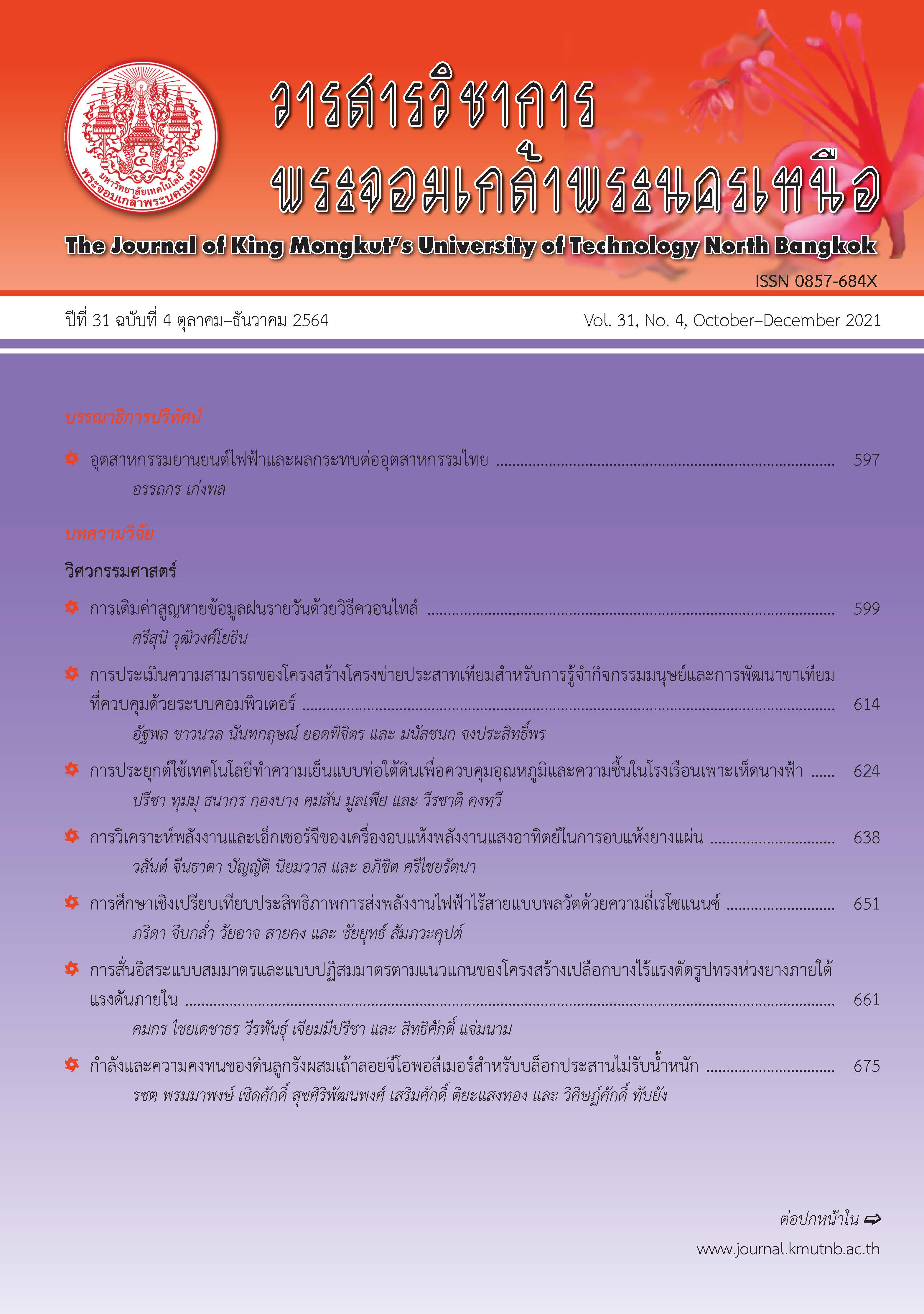การประเมินความสามารถของโครงสร้างโครงข่ายประสาทเทียมสำหรับการรู้จำกิจกรรมมนุษย์และการพัฒนาขาเทียมที่ควบคุมด้วยระบบคอมพิวเตอร์
Main Article Content
บทคัดย่อ
ระบบรู้จำกิจกรรมมนุษย์สำหรับขาเทียมที่ควบคุมด้วยระบบคอมพิวเตอร์สามารถส่งเสริมให้ผู้สวมใส่มีความสะดวกและการเคลื่อนไหวได้เป็นธรรมชาติมากยิ่งขึ้น แบบจำลองโครงข่ายประสาทเทียมที่ถูกพัฒนาในการศึกษาครั้งนี้ เพื่อจำแนกกิจกรรมการเคลื่อนไหวโดยใช้ข้อมูลเซนเซอร์แอคเซเลอโรมิเตอร์และไจโรสโคป ชุดข้อมูลการเดินที่มีการเปิดเผยต่อสาธารณะจากผู้ทดลอง 30 คน มีอายุอยู่ในช่วง 19 ถึง 48 ปี แต่ละคนดำเนิน 6 กิจกรรม ได้แก่ การเดินที่ความเร็วปกติ เดินขึ้นบันได เดินลงบันได ท่านั่งปกติ ยืนตัวตรง และ การนอน ข้อมูลชุดนี้ถูกนำมาใช้ฝึกอบรมและทดสอบแบบจำลองโครงข่ายประสาทเทียม จำนวนเซลล์ประสาทในชั้นซ่อนถูกตั้งค่าโดยการเพิ่มทีละ 1 เซลล์ โดยเริ่มจากจำนวน 1 เซลล์ จนถึง 200 เซลล์ จนกว่าโครงข่ายให้ความถูกต้อง ความไว และ ความจำเพาะสูงที่สุด โครงข่ายแบบป้อนไปข้างหน้าและวิธีการเรียนรู้แบบส่งค่าย้อนกลับถูกใช้ในการสร้างแบบจำลองโครงข่ายประสาทเทียม ผลการทดลองพบว่าจำนวนเซลล์ประสาทที่เหมาะสมในชั้นซ่อนเท่ากับ 73 เซลล์ แบบจำลองโครงข่ายประสาทเทียมนี้สามารถนำไปใช้ในการพัฒนาขาเทียมที่ควบคุมด้วยระบบคอมพิวเตอร์
Article Details
บทความที่ลงตีพิมพ์เป็นข้อคิดเห็นของผู้เขียนเท่านั้น
ผู้เขียนจะต้องเป็นผู้รับผิดชอบต่อผลทางกฎหมายใดๆ ที่อาจเกิดขึ้นจากบทความนั้น
เอกสารอ้างอิง
[2] Department of Empowerment of Persons with Disabilities, “Situation Report on Persons with Disabilities in Thailand,” Ministry of Social Development and Human Security, Bangkok, Thailand, 2017 (in Thai).
[3] N. Yodpijit, M. Jongprasithporn, U. Khawnuan, T. Sittiwanchai, J. Siriwatsopon, and G. Guerra. (2018, June). Human-centered design of computerized prosthetic leg: A questionnaire survey for user needs assessment. [Online]. Available: https://link.springer.com/chapter/10.1007/978-3-319-94947-5_98
[4] E. Zheng, B. Chen, X. Wang, Y. Huang, and Q. Wang, “On the design of a wearable multi-sensor system for recognizing motion modes and sit-tostand transition regular paper,” International Journal of Advanced Robotic Systems, vol. 11, no. 30, pp. 1–8, 2014.
[5] Z. Yu and M. Lee, “Human motion based intent recognition using a deep dynamic neural model,” Robotics and Autonomous Systems, vol. 71, pp. 134–149, 2015.
[6] H. Huang, T. A. Kuiken, and R. D. Lipschutz, “A strategy for Identifying locomotion modes using surface electromyography,” IEEE Transactions on Bio-medical Engineering, vol. 56, no. 1, pp. 65–73, 2009.
[7] B.hen, E. Zheng, X. Fan, T. Liang, Q. Wang, K. Wei, and Long Wang, “Locomotion mode classification using a wearable capacitive sensing system,” IEEE Trans Neural Syst Rehabil Eng, vol. 21, no. 5, pp. 744–755, 2013.
[8] I. A. Basheer and M. Hajmeer, “Artificial neural networks: Fundamentals, computing, design, and application,” Journal of Microbiological Methods, vol. 43, no. 1, pp. 3–31, 2000.
[9] B. G. Zhang and M. Y. H. Eddy Patuwo, “Forecasting with artificial neural networks:The state of the art,” International Journal of Forecasting, vol. 14, no. 1, pp. 35–62, 1998.
[10] J. Reyes-Ortiz, D. Anguita, A. Ghio, L. Oneto, and X. Parra. (2019, April). UCI machine learning repository: Human activity recognition using smartphones data set, 2012. [Online]. Available: https://archive.ics.uci.edu/ml/datasets/human+activity+recognition+using+smartphones
[11] K. L. Du and M. N. S. Swamy, Neural Networks in a Softcomputing Framework. Springer Science & Business Media, 2006.
[12] A. Baratloo, M. Hosseini, A. Negida, G. El Ashal, and G. El Ashal, “Part 1: Simple definition and calculation of accuracy, sensitivity and specificity,” Archives of Academic Emergency Medicine (Emergency), vol. 3, no. 2, pp. 48–49, 2015.
[13] H. Abdi, “Signal detection theory,” in Encyclopedia of Measurement and Statistics, 3rd ed., Elsevier, 2007, pp. 313–324.
[14] C. D. Wickens and J. G. Hollands, “Signal detection, information theory, and absolute judgment,” in Engineering Psychology and Human Performance, Prentice Hall, 2000, pp. 17–28.
[15] A. Ignatov, “Real-time human activity recognition from accelerometer datausing convolutional neural networks,” Applied Soft Computing Journal, vol. 62, pp. 915–922, 2018.
[16] U. Martinez-Hernandez and A. A. Dehghani-Sanij, “Adaptive bayesian inference system for recognition of walking activities and prediction of gait events using wearable sensors,” Neural Networks, vol. 102, pp. 107–119, 2018.
[17] S. Au, M. Berniker, and H. Herr, “Powered ankle-foot prosthesis to assist level-ground and stair-descent gaits,” Neural Networks, vol. 21, no. 4, pp. 654–666, 2008.
[18] M. M. Hassan, M. Z. Uddin, A. Mohamed, and A. Almogren, “A robust human activity recognition system using smartphone sensors and deep learning,” Future Generation Computer Systems, vol. 81, pp. 307–313, 2018.

